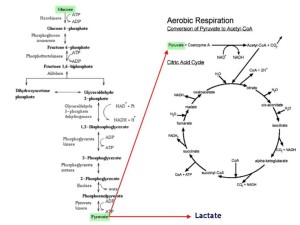I am often asked how to become a better runner. The answer is simple… and complex. As Albert Einstein said, “Everything should be made as simple as possible, but not simpler.” So, in honor of Einstein (whom I share a birthday with), here is a simple explanation of how to become a better runner. Understand this picture and the words beneath it and you understand a lot. (I know it’s a little blurry when I enlarged it, but it’s still understandable).
When you run, you use carbohydrate (glucose) and fat. Glucose is metabolized and produces pyruvate, which has 2 fates: oxidation in the Krebs (Citric Acid) Cycle, or chemical reduction to lactate. (I discuss lactate in another blog, My Love Affair with Lactate.)
When you run slowly, the pyruvate that is formed from glucose metabolism is directed into the Krebs Cycle. When you run faster, you rely more on glucose and less on fat, which produces more pyruvate, and you begin to put a strain on the ability of the Krebs Cycle to “accept” more pyruvate. At some pace, which is different for everyone, the Krebs Cycle becomes overwhelmed and can’t keep up with the production of pyruvate from glycolysis. When this happens, the pace starts to become more “anaerobic,” with anaerobic metabolism playing a more significant role to supply energy (ATP) for muscle contraction. Lactate accumulates in the muscles and blood, along with other metabolites, like hydrogen and potassium ions, which cause fatigue.
The goal of training for a distance runner is to make the pace as fast as possible whereby pyruvate continues to be directed into the Krebs Cycle, delaying the reliance on anaerobic metabolism. An out of shape runner may become anaerobic at 8 minutes per mile, while the best runners in the world become anaerobic at 4 minutes per mile.
[tweetthis remove_twitter_handles=”true” remove_url=”true” remove_hidden_hashtags=”true” remove_hidden_urls=”true”]To become better runner, train to direct pyruvate into Krebs Cycle at as fast a pace as possible, delaying reliance on anaerobic metabolism.[/tweetthis]
So how do you increase the pace at which pyruvate continues to be directed into the Krebs Cycle? By running more and by running at a faster aerobic pace, because that kind of training increases the metabolic machinery needed to accept more pyruvate. The Krebs Cycle and all of its associated enzymes are inside the mitochondria. The more mitochondria you have in your leg muscles, the greater the capacity of those muscles to run aerobically. Running more also increases the amount of capillaries you have surrounding your muscle fibers, which enhances oxygen delivery to your muscles.
It is for this reason — enhanced Krebs Cycle activity through stimulating the production of more mitochondria — that runners must run a lot to become better. There you have it — simple as possible, but not simpler. Now go run.
And if you haven’t read my latest book, THE INNER RUNNER, buy the book for yourself and another for a friend. It is a great holiday gift. And it will touch your heart. Not a bad thing to do for the holidays.
https://www.amazon.com/Inner-Runner-Successful-Creative-Confident/dp/1634507959


One Response to Einstein, Pyruvate, and Simplicity